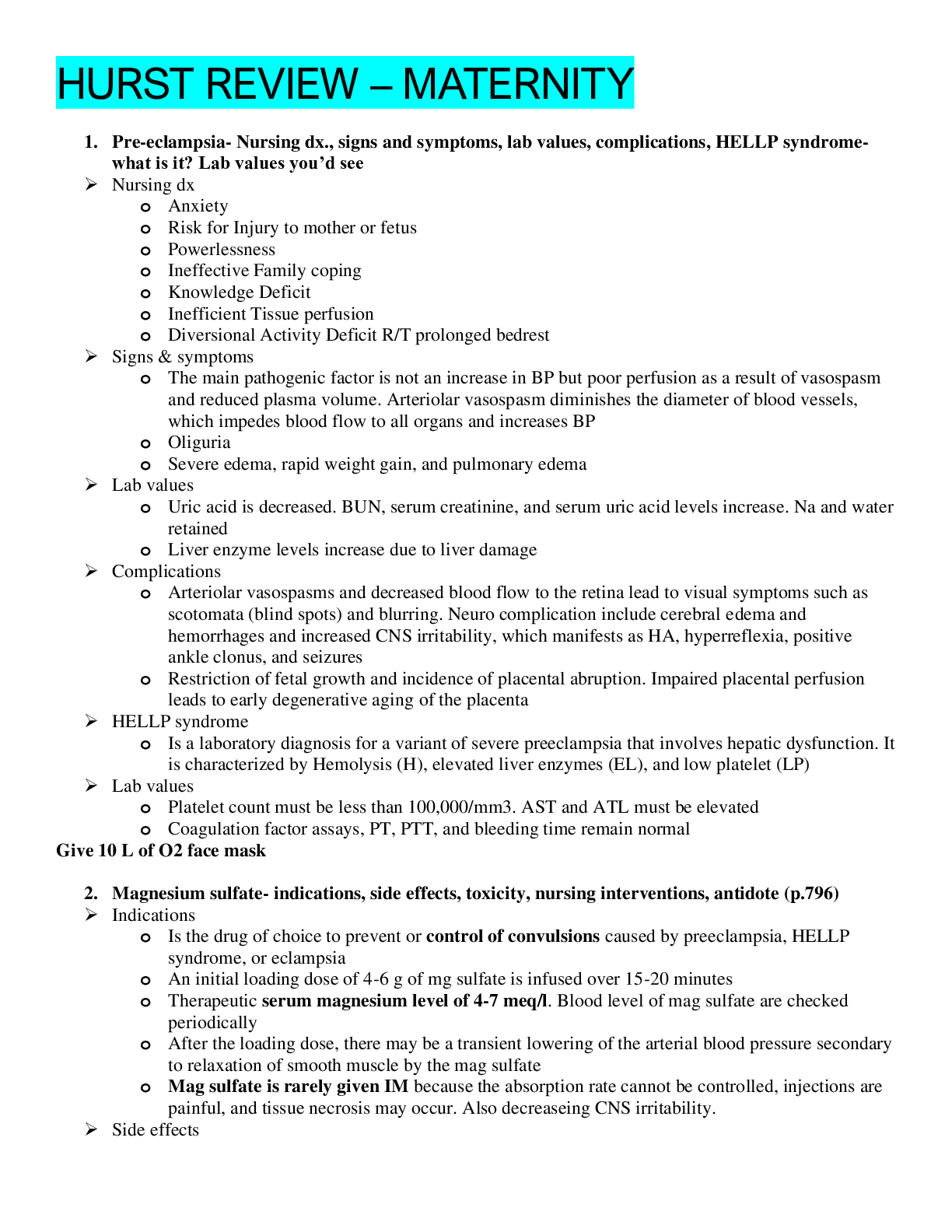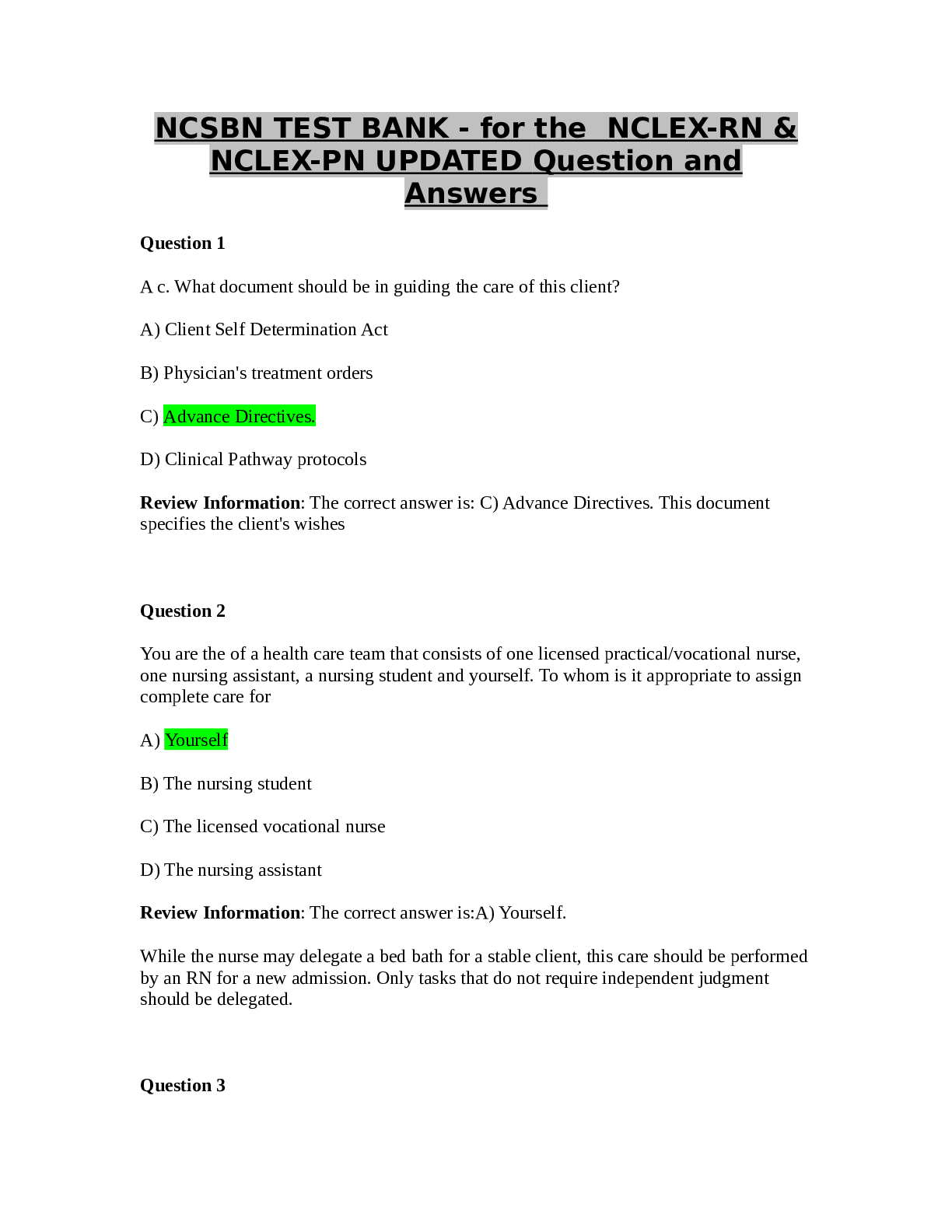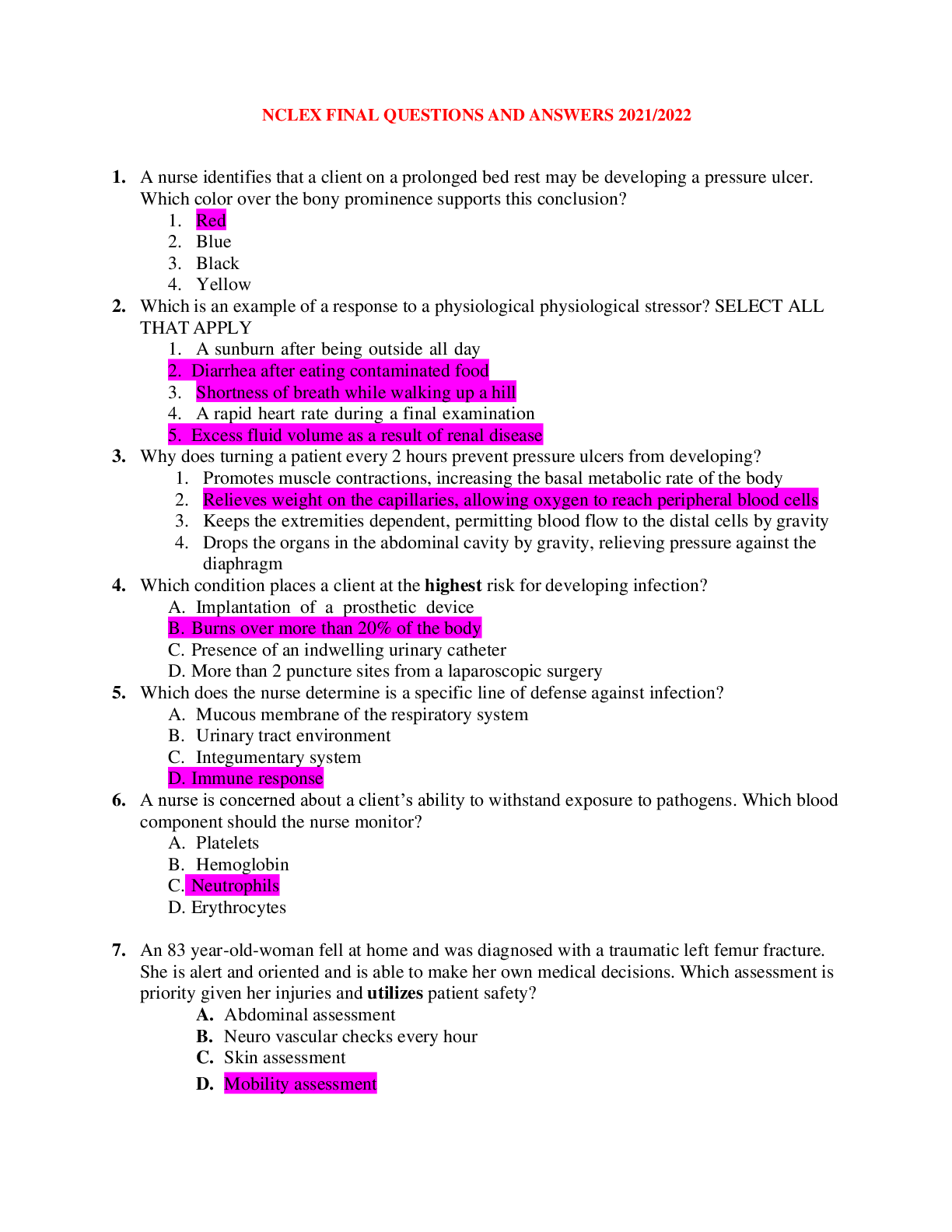HURST REVIEW – MATERNITY ( complete A+ guide_2020/2021)
Document Content and Description Below
HURST REVIEW – MATERNITY 1. Pre-eclampsia- Nursing dx., signs and symptoms, lab values, complications, HELLP syndrome- what is it? Lab values you’d see Nursing dx o Anxiety o Risk for In... jury to mother or fetus o Powerlessness o Ineffective Family coping o Knowledge Deficit o Inefficient Tissue perfusion o Diversional Activity Deficit R/T prolonged bedrest Signs & symptoms o The main pathogenic factor is not an increase in BP but poor perfusion as a result of vasospasm and reduced plasma volume. Arteriolar vasospasm diminishes the diameter of blood vessels, which impedes blood flow to all organs and increases BP o Oliguria o Severe edema, rapid weight gain, and pulmonary edema Lab values o Uric acid is decreased. BUN, serum creatinine, and serum uric acid levels increase. Na and water retained o Liver enzyme levels increase due to liver damage Complications o Arteriolar vasospasms and decreased blood flow to the retina lead to visual symptoms such as scotomata (blind spots) and blurring. Neuro complication include cerebral edema and hemorrhages and increased CNS irritability, which manifests as HA, hyperreflexia, positive ankle clonus, and seizures o Restriction of fetal growth and incidence of placental abruption. Impaired placental perfusion leads to early degenerative aging of the placenta HELLP syndrome o Is a laboratory diagnosis for a variant of severe preeclampsia that involves hepatic dysfunction. It is characterized by Hemolysis (H), elevated liver enzymes (EL), and low platelet (LP) Lab values o Platelet count must be less than 100,000/mm3. AST and ATL must be elevated o Coagulation factor assays, PT, PTT, and bleeding time remain normal Give 10 L of O2 face mask 2. Magnesium sulfate- indications, side effects, toxicity, nursing interventions, antidote (p.796) Indications o Is the drug of choice to prevent or control of convulsions caused by preeclampsia, HELLP syndrome, or eclampsia o An initial loading dose of 4-6 g of mg sulfate is infused over 15-20 minutes o Therapeutic serum magnesium level of 4-7 meq/l. Blood level of mag sulfate are checked periodically o After the loading dose, there may be a transient lowering of the arterial blood pressure secondary to relaxation of smooth muscle by the mag sulfate o Mag sulfate is rarely given IM because the absorption rate cannot be controlled, injections are painful, and tissue necrosis may occur. Also decreaseing CNS irritability. Side effects o Feel flushed, hot, and sedated, especially during the bolus, HA, visual disturbances, epigastric pain Toxicity o Early symptoms of toxicity include nausea, a feeling of warmth, flushing, muscle weakness, decreased reflexes, and slurred speech o Loss of patellar reflexes, respiratory depression, oliguria, and decreased LOC are sign of toxicity. Action must be taken to prevent respiratory or cardiac arrest. If mag toxicity is suspect, the infusion should be DC immediately. Nursing interventions o *The woman’s BP, P, resp status should be monitored closely while the loading dose is being administered IV, and q15-30 mins at other times, depending on the stability of the woman’s condition o Assess for signs/symptoms of mag toxicity. Nausea , warmth, flushing muscle weakness decreases reflexes ( disappears) and slurred speech, rr depression, oliguria, decreased LOC, o Monitor RR if < 10 stop mag. o Because mag circulates free and unbound to protein and is excreted in the urine, accurate recordings of maternal urine output must be obtained (intake 100-125, output >30ml/h) stop the mag Antidote o Calcium gluconate, the antidote for mag sulfate is ordered (10ml of a 10% solution, or 1g) and given by slow IV push (usually by the MD) over at least a 3 minute period to avoid undesirable reactions such as arrhythmias, bradycardia, and V-fib 3. HTN- treatment, fetal risks (p.802) o The goal of treatment is to maintain a blood pressure below 150 to 160mm Hg systolic and 100 to 110mm Hg diastolic o Since all antihypertensive medications are found in breast milk, the drug of choice for women who breastfeed is methyldopa or hydralazine (if methyldopa is not effective) o Fetal effects include fetal growth restriction and small for gestational age infants o Decrease sodium exercise, limit caffine, alcohol and tobacco, perform bld pressure and fetal movement counting and important bed rest. 4. Epilepsy and pregnancy- meds, risks • Risk of vaginal bleeding doubled and threefold risk of abruption placentae. Abnormal presentations more common, increased possibility that fetus will experience seizure inutero. Failure to take meds is a common factor leading to worsening of seizure activity during pregnancy (more frequent 1st trimester). Monotherapy and the use of the smallest dose possible to control seizures. Congenital anomalies that can occur with AEDs – cleft lip/palate, heart defects, urogenital defects, neural tube defects. Prescribed AEDs should be taken with folic acid. Fetal monitoring also required. Neonatal – hemorrhagic disorders associated with AED – induced vit. K deficiency. Mother – Vit. K during last month; newborn – IM Vit K. pages 868-869. 5. Trauma- assessment, priorities • Primary – ABCs – airway, breathing, circulatory volume; cervical spine injury (assumed until ruled out). Assess for obvious trauma – bleeding, fx, penetrating wounds, flail chest, etc. 2 large bore IVs, blood draw. After 20 weeks lie pt on side to help blood flow if possible. Establish baseline neuro status • Secondary – complete physical assessment of all systems. Greatest concern – abruption placentae, fetal monitor, ultrasound, x-ray. MOTHERS HEALTH BEFORE BABY. • Perimortem C-section – within 20 minutes (rarely successful). Pages 891-897 need to look over. >>>>>>>>>>>>>>>>>>>>>>>>>>>>>>>>>>>>>CONTINUES>>>>>>>>>>>>>>>>>>>>> [Show More]
Last updated: 2 years ago
Preview 1 out of 7 pages

Buy this document to get the full access instantly
Instant Download Access after purchase
Buy NowInstant download
We Accept:

Reviews( 0 )
$8.00
Can't find what you want? Try our AI powered Search
Document information
Connected school, study & course
About the document
Uploaded On
Nov 19, 2020
Number of pages
7
Written in
Additional information
This document has been written for:
Uploaded
Nov 19, 2020
Downloads
0
Views
210







.png)


